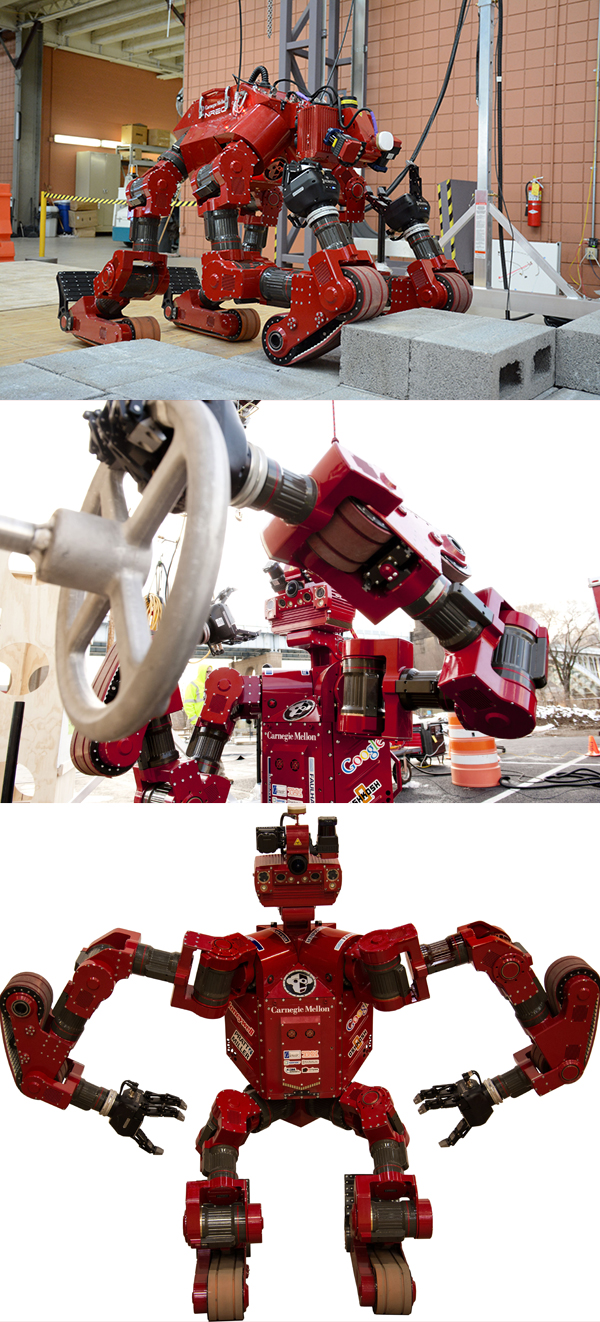Carnegie Mellon’s CHIMP Robot Prepares For DARPA Robotics Challenge Trials, Dec. 20-21 National Robotics Engineering Center Putting Robot Through Its Paces
Byron SpiceFriday, December 13, 2013Print this page.

PITTSBURGH—It’s only been a few weeks since Carnegie Mellon University’s National Robotics Engineering Center (NREC) completed assembly of its four-limbed CHIMP robot, but the Tartan Rescue Team has high hopes for the robot’s performance at the DARPA Robotics Challenge (DRC) Trials Dec. 20-21.
"We’ve been on a fast track for the past year, doing detailed design and development of CHIMP at the same time as we were writing and testing its software on surrogate hardware,” said Tony Stentz, NREC director and leader of the Tartan Rescue Team. “That’s an aggressive approach to producing a robot unlike any we have built and not without risk, but it appears to be paying off.
“The software allowed us to investigate a number of issues that influenced the design of the hardware and improved the robot,” he continued. “Even though we would love to have more time to practice with CHIMP prior to the trials, we’ve been pleased so far with its performance.”
Tartan Rescue is one of 17 teams competing at the DRC Trials at the Homestead-Miami Speedway in Homestead, Fla. Sponsored by the Defense Advanced Research Projects Agency (DARPA), the DRC is intended to spur development of advanced robots that can mitigate disasters while working in environments engineered for people. Based on performance at the trials, up to eight teams will receive DARPA funding to help prepare for the DRC Finals next December.
CHIMP — the CMU Highly Intelligent Mobile Platform — is a human-size robot that, when standing, is 5-foot-2-inches tall and weighs about 400 pounds. It is not a dynamically balanced walking robot, but is a statically stable robot designed to move on tank-like treads affixed to each of its four limbs. When it needs to operate power tools, turn valves, or otherwise use its arms, CHIMP can stand and roll on its leg treads.
The robot’s long front arms — its wingspan is almost 10 feet — give it an ape-like appearance.
During the trials, each robot will be given 30 minutes to attempt each of eight different challenges, such as clearing debris, closing valves, handling a fire hose, climbing stairs and crossing uneven terrain. In the final competition next December, robots will face a disaster scenario that will involve a number of these or similar challenges.
CHIMP’s joints consist of one of four different sizes of drive joints designed at the NREC. They combine frameless motors with torque-limiting clutches, integrated brakes and gearing to provide precise control and high power density. The most powerful of these joints is capable of curling 300 pounds. The arms each have seven joints and the legs each have six. Overall, the robot has 39 motors, including the ones that turn a pair of laser radars, or lidars, on its head.
 The Tartan Rescue Team
The Tartan Rescue TeamThe lidars enable CHIMP to create a 3D map of its surroundings, which in turn gives its operators a global view showing where CHIMP is located within the environment, much like a video game. Operators use the 3D imagery as well as several video cameras mounted in CHIMP’s head to direct the robot’s actions. The robot operates autonomously to protect itself from falling and to perform certain tasks, while remote operators provide guidance on where to drive, what to grasp and which way to turn a valve.
The Tartan Rescue Team is 50 members strong, drawing from the NREC technical staff as well as faculty, staff and students from CMU’s Robotics Institute. A core group of about 10 people work full-time on the project. In addition to Stentz, the team leadership includes David Stager, systems lead; Clark Haynes, software lead; Eric Meyhofer, mechanical systems lead; Herman Herman, sensor pod and electronics lead; and Alonzo Kelly, software lead for positioning. Max Likhachev, Drew Bagnell and Sidd Srinivasa are providing technical guidance, personnel and technical components.
As a DRC Track A team, Tartan Rescue received $3 million from DARPA to help develop CHIMP. Also key to the robot’s development are the team’s sponsors: Kollmorgen, Faulhaber, Google, Honeywell, Pratt & Miller, Robotiq, JLG, Oshkosh, THK, Harmonic Drive, Elmo Motion Control, Eclipse Metal Fabrication, Sepac, AGM, Glenair and Bren-Tronics.
NREC is part of Carnegie Mellon’s acclaimed Robotics Institute. It performs advanced applied research and develops prototypes for a variety of corporate and government sponsors.
More information on CHIMP and the team, including images and video, is available online at http://www.rec.ri.cmu.edu/projects/tartanrescue/
NREC and the Robotics Institute are part of CMU’s School of Computer Science. Follow the school on Twitter @SCSatCMU and follow the Tartan Rescue Team @TartanRescue. Also look for the team on Google+, Facebook, Instagram and YouTube.
Byron Spice | 412-268-9068 | bspice@cs.cmu.edu
